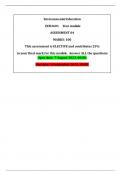Other
EED2601 assignment 4 Due 06 SEPTEMBER 2023
- Institution
- University Of South Africa (Unisa)
ACTIVITY 1 1.1 Progress towards achieving sustainability can be gauged using sustainability indicators. 1.1.1. Mention any two sustainability indicators. (2) 1.1.2. State four examples of the application of the above-mentioned sustainability indicators. (4) 1.2 Define sustainable de...
[Show more]



